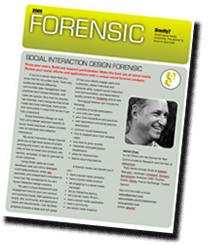Thus at bottom the message already no longer exists; it is the medium that imposes itself in its pure circulation ... the universe of communication ... leaves far behind it those relative analyses of the universe of the commodity. All functions abolished in a single dimension, that of communication. That's the ecstasy of communication. All secrets, spaces and scenes abolished in a single dimension of information. That's obscenity. The hot, sexual obscenity of former times is succeeded by the cold and communicational, contactual and motivational obscenity of today..." —
Jean Baudrillard,
Ecstasy of Communication
We "are now in a new form of schizophrenia ... The schizo is bereft of every scene, open to everything in spite of himself, living in the greatest confusion. He is himself obscene, the obscene prey of the world's obscenity ... He is now only a pure screen, a switching center for all the networks of influence..." —
Jean Baudrillard,
Ecstasy of Communication
"Now I think that it would be better to reveal myself" Mr. Ternovskiy, builder of Chatroulette, referring to a less graphic kind of transparency, in
Chatroulette's Creator, 17, Introduces Himself, The New York Times
As is generally the case with a new application on the Internet, and with social applications in particular, users are queuing in large numbers for a peek into the random universe of ChatRoulette. The site is a rabbit hole for voyeurs and exhibitionists alike, mutually and symbiotically united in a simulcast trip through the looking glass in the age of social media.
Viewer discretion is advised, and if you are even mildly sensitive to social allergens, you may wish to keep the lens cap on and your eyes behind a good pair of wrap-arounds, for there is indeed a lot of flashing going on in the aptly named "surreal" world of ChatRoulette (
@nickbilton).
What explains the proliferation of nudity and exposure in ChatRoulette (and video chat systems like it)? Is there, as Nick Bilton asks in his review of the service, "a nascent desire for anonymity online."
This doesn't add up for me. There is desire, yes, but not for anonymity.
Nick writes, in
The Surreal World of Chatroulette: "our lives used to be private by default, yet with the advent of each new social network, privacy has become increasingly difficult to preserve." But were our lives private by default? Have we not, through practices social and cultural, always sought out and crafted arts by means of which to expose and express ourselves on stage, in front of audiences of all kinds?
The point that social networking threatens to undermine privacy is a point taken, but not as an explanation of the social practices that so easily and readily spring sites like ChatRoulette to life. It is much more likely that there is in ChatRoulette's ability to send users "parachuting into someone else's life" a kind of mediated proximity, realtime in that it's live, co-present in that it telescopes a kind of social watching, intimate in its on-screen coupling, and spectacular in how it attracts attention.
Take desire — a force most decidedly at work in ChatRoulette. Desire desires the desire of the other, as French philosopher Lacan put it. Desire would not desire anonymity — but the desiring person may desire to be seen anonymously. And to anonymously share this desire with another anonymous person. Desire is, when mediated in online adult webcam chats, and between consenting users of ChatRoulette, amplified according to its own internal social inclinations. Desire is for the other's desire: it is reciprocating. This is precisely what Chatroulette does: it shows you the Other.
The modality of the medium in this case is visual. And because it involves seeing people, and seeing them live, it will be about watching. This is the social modality by which users will relate, and the activity in this kind of sociality will necessarily involve the kinds of action coordination, synchonrization, mirroring, and other mutually-interesting aspects of watching one another remotely.
Watching, and being watched. Those are the perceptual senses involved, and thus the basis of communication. So if desire is at play, it is at play in getting attention. At play in self disclosure. At play in the thrill and surprise of synchronizing with another user. But by means of seeing and being seen (mutual recognition is being seen), of watching and being watched (anonymity is watched).
This coupling is an example of one very simple answer to asynchronous communication otherwise so common online. We push media for what they bracket out of social experience, and press at the margins to discover where the medium produces its most uncanny, unsettling, and weird effects. Webchats are live, are a kind of realtime streamtime that occurs in time (feedtime?). In time, not asynchronously and out of time, not in separate streams of user messaging flowing alongside one another's times. A live and streaming realtime. Which means co-presence.
Presence online can be established by artifact and extension, which is normally the case when we are present but not really (available but by notification only, and presented by means of re-presentation of text, messages, etc.). This kind of presence, which we have called ambient presence, is sensed but not seen, makes it into one's awareness but is not verified, and may be social without placing immediate demands on participation. One can be present and fake it this way too. One can be present by proxy. But there's no faking it on webcam, no proxy presence when there's immediacy and an intimate proximity.
Presence by cam is not mediated by text or other artifact. It's truly present. And here the co-presence of seeing and being seen, watching and being watched, and the uncanny special effect of closed-circuit mirroring in mediated interactions with which we also see ourselves seeing ourselves being seen, and can watch ourselves watching while being watched, couples us to others, anonymously or not.
This coupling resolves an ontological crack in the conventional online experience of asynchronous participation: the separation and disconnection of online connectedness. With the exception of webcam and VOIP applications, online social media are one-sided. They present us with a one-sided and unilateral view of interaction and communication.
Not on twitter, on Facebook, or any other social platform do we see what the other sees, view what the audience views, read what another is reading. Webcam chat hookups like ChatRoulette unify the experience in a single and shared (although mediated) reality. (Imagine that we might see another person's twitter view in a split pane. How would that change our sense of the social?)
I wrote last week about the possibility of
coupling realtime activity streams, as in twitter, Facebook status updates, and the like. I speculated that coupled posts would permit communication to become action, as users would then be able to respond directly to posts across systems. And that
action streams might also permit users to use messages to act — such as send or reply to invitations, purchase tickets, and so on.
Chatroulette is an example of coupled realtime streams. But being live feeds, and being webcam feeds, mutually-visible and coupled activities are up to the user's imagination. No meta is required for the transmission of live activity on camera.
Live feeds may be contrasted further still with the temporality of realtime message streams. I've argued that realtime activity streams are still experienced by users in their own time. That
streamtime is not a shared experience of time. In webcam chat time is shared, users are in one another's time, creating a stretch of shared time together. This solves a problem that realtime messaging applications suffer from: the ordering of messages delivered in realtime.
Realtime messages are delivered in chronological order. But this order bears no relation to message content or context. It is simply the order in which they arrive. Consequently, the order created by design, and by means of which messages are posted and displayed, adds no value and supplies no narrative or conversational threading to the content itself (or for that matter to its authors). The realtime temporality of message delivery is extrinsic to its meaning.
Which is in part why the medium creates so much noise and redundancy. For in any social medium, attention is the resource with which the engine keeps running.
Attention is focused in webcam experiences fundamentally differently than it is in experiences that use the screen for display and re-presentation. (See
yesterday's post.) The screen modality of webcam chat uses "windows" through which we see the other user(s). Obviously, then, our attention is on what we see (including ourselves seen seeing). And because social media are about giving and getting attention, we hold the attention of the other by visual spectacle. In visual media, attention goes to that which is the most compelling, riveting, ridiculous, funny, or obscene. In short the "sociality of the spectacle."
Which brings us, finally, to devolution and the corruption of social media experiences. Communication and attention being the scarce resource in a medium that produces surplus and excess, a seemingly unavoidable systemic process of negentropy often accompanies the rise of noise and redundancy that occurs with system growth. Negentropy is the phenomenon of increasing order, and it appears in uncoordinated social systems as self-reinforcing dynamics emerge around common practices. Unfortunately, but not surprisingly, order will generally emerge around the lowest common denominator: the form, content, performance or expression most likely to communicate (get attention).
In Chatroulette, this is already the obscene. Obscenity, like the raunchy and ridiculous, make for compelling viewing and will thus always attract attention. Attention is sought after by the individual, and secured by the sustained engagement of one other viewer (or roomful of viewers, but one view). The spectacle is singularly interesting.
But in realtime streaming services like twitter, attention is sought amidst a massive audience in a constant flow of messages. Thus repetition is the lowest common denominator in twitter: the trending topic or bit of news whose headline and social significance are gaining the attention of the audience at large. A reference to common knowledge and news, including gossip, rumor, and hearsay, secures attention. Not the spectacle of the singularly fascinating sight, but the spectacle of the massively popular hit or trend.
The sociality of twitter thus involves the attention-grabbing awareness of an audience becoming community or populace. Focusing the awareness of all on one unifying theme. The sociality of ChatRoulette involves the attention-getting focus of one, creating the intimacy of a couple for a stretch of time outside the view of the rest.
And so it is, in my view, that the answer to Nick's question is not that in an age of public social networking we desire its opposite, anonymity. But that in any mediated social experience a number of intrinsic transformations of experience that involve our senses, our interest in others, communication and its modes, and the construction of unique mediated realities, together fashion the constraints and opportunities for paying attention in new ways. Hulu would do well to consider a co-viewing option (perhaps initially pre-screened and using community flagging norms) instead of a messaging platform. After all, ChatRoulette shows us that if it's not anonymity we desire, we do desire new experiences with others.
Labels: media theory, realtime, sxd, twitter






